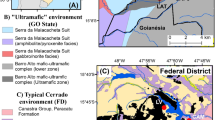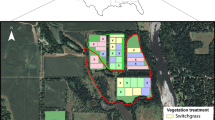Summary
Dittrichia (ex Inula) viscosa is a ruderal species that has recently become an invading plant in the northwest Mediterranean basin. A previous study failed to demonstrate the occurrence of morphologically differentiated ecotypes among populations of the species but suggested the existence of nutritional ecotypes. This latter possibility is examined here by comparing the ability of plants from contrasting habitats to control cation accumulation balance. Dittrichia viscosa plants, from eight siliceous habitats and nine calcareous habitats of southern France and neighbouring Spain and Italy, were cloned and grown together hydroponically with a solution simulating an acid soil with an aluminium constraint. Two independent hydroponic units containing solution supplemented with two levels of Al were used (2 Al levels x17 populations x3 genotypes x3 replicates). The growth and cation content (K, Ca, Mg and Na) of plant shoots and the chemical composition of the soil of each habitat were analysed. At the high Al level (1.1mm), populations differed in K, Ca and Mg plant proportions. Two groups could be distinguished: one containing all but one siliceous populations and the other containing all but one calcareous populations. Plants of the siliceous group accumulated proportionally more K and less Ca, and had better growth, than plants of the calcareous group, in the same way as calcifuge and calcicole species when grown on acid soil. At the lowest Al level (0.37mm), differences between siliceous and calcareous populations were less marked. The results suggest that differences in the ability of plants to control K and Ca balance, which appear to be of adaptive significance, could have arisen through selection, and that Dittrichia viscosa has evolved calcifuge and calcicole nutritional ecotypes in siliceous and calcareous habitats respectively. Various degrees of calcifugy, and to a lesser extent of calcicoly, can thus be suggested to occur among the studied populations, some in relation to the intensity of mineral stress in the natural habitats. So far, only functional traits have provided evidence of ecotypic differentiations within Dittrichia viscosa.
Similar content being viewed by others
References
Antonovics J, Bradshaw AD, Turner RG (1971) Heavy metal tolerance in plants. In: Cragg J (ed) Advances in Ecological Research, vol 7. Academic Press, London, pp 1–85
Asp H, Bengtsson B, Jensén P (1988) Growth and cation uptake in spruce (Picea abies Karst.) grown in sand culture with various aluminium contents. Plant Soil 111:127–133
Baus Picard J (1986) L'accumulation des cations (K, Ca, Mg, Na et Fe) et l'adaptation de Dittrichia (ex Inula) viscosa W. Greuter, aux sols acides et calcaires. Thèse Doctorat, Université Montpellier II
Baus Picard J, Wacquant JP (1990) Simulation of an acidic soil in sand culture. C R Acad Sci Paris 311:269–274
Bengtsson B, Asp H, Jensén P, Berggren D (1988) Influence of aluminium on phosphate and calcium uptake in beech (Fagus sylvatica) grown in nutrient solution and soil solution. Physiol Plant 74:299–305
Boonne C (1990) Micropropagation in vitro de Dittrichia viscosa W. Greuter et tolérance des plantes juvéniles aux contraintes minérales. Thèse Doctorat, Université Montpellier II
Bradshaw AD (1971) Plant evolution in extreme environments. In: Creed R (ed) Ecological genetics and Evolution. Blackwell Scientific Publications, Oxford, pp 20–50
Bradshaw AD (1984) Ecological significance of genetic variation between populations. In: Dirzo R, Sarukhàn J (eds) Perspectives on Plant Population Ecology. Sinauer Associates, Sunderland, pp 213–228
Bradshaw AD, Hardwick K (1989) Evolution and stress-genotypic and phenotypic components. Biol J Linn Soc 37:137–155
Davies MS (1975) Physiological differences among populations of Anthoxanthum odoratum L. collected from the park grass experiment, Rothamsted. IV Response to potassium and magnesium. J Appl Ecol 12:953–974
Davis PH, Heywood VH (1963) Principles of Angiosperm taxonomy. Oliver and Boyd, Edinburgh and London
De Bilde J (1984) Etude sur la systématique synthétique du Silene nutans L. (Caryophyllaceae) en Europe Nord-occidentale. Thèse Doctorat en Sciences, Université Libre de Bruxelles
Diday E (1971) Une nouvelle méthode en classification automatique et reconnaissance des formes. La méthode des nuées dynamiques. Rev Stat Appl 19:19–33
Epstein E (1972) Mineral Nutrition of Plants. John Wiley and Sons Inc., New York
Grauer UE, Horst WJ (1990) Effect of pH and nitrogen source on aluminium tolerance of rye (Secale cereale L.) and yellow lupin (Lupinus luteus L.). Plant Soil 127:13–21
Gregor JW (1944) The ecotype. Biol Rev 19:20–30
Grignon C, Sentenac H (1991) pH and ionic conditions in the apoplast. Annu Rev Plant Physiol Plant Mol Biol 42:103–128
Grime JP, Hodgson JG (1969) An investigation of the ecological significance of lime-chlorosis by means of large-scale comparative experiments. In: Rorison IH (ed) Ecological Aspects of the Mineral Nutrition of Plants. Blackwell Scientific Publications, Oxford, pp 67–99
Hamzé M, Wacquant JP (1984) Chlorose des agrumes en sol calcaire et transport d'ions minéraux. In: Martin-Prével (éd) Actes VIè Colloque International pour l'Optimisation de la Nutrition des Plantes, Montpellier vol III. CIRAD, Montpellier, pp 949–956
Humphreys MO, Bradshaw AD (1977) Genetic potentials for solving problems of soil mineral stress: Heavy metal toxicities. In: Wright MJ (ed) Plant Adaptation to Mineral Stress in Problem Soils. Proceedings Workshop, Beltsville. Cornell University, New York, pp 95–105
Kinzel H (1983) Influence of limestone, silicates and soil pH on vegetation. In: Lange OL, Nobel PS, Osmond CB, Ziegler H (eds) Physiological plant ecology III. (Encyclopedia of plant physiology, vol 12C). Springer, Berlin, pp 201–244
Korcak RF (1987) Satisfying and altering edaphic requirements for acidophilic plants. J Plant Nutr 10:1071–1078
Lovett Doust L (1981) Population dynamics and local specialization in a clonal perennial (Ranunculus repens). II The dynamics of leaves, and a reciprocal transplant-replant experiment. J Ecol 69:757–768
McGraw JB (1987) Experimental ecology of Dryas octopetala ecotypes. IV Fitness response to reciprocal transplanting in ecotypes with differing plasticity. Oecologia 73:465–468
Marschner H (1986) Mineral Nutrition of Higher Plants. Academic Press, London
Marschner H (1991) Mechanisms of adaptation of plants to acid soils. Plant Soil 134:1–20
Passama L (1970) Composition minérale de diverses espèces calcicoles et calcifuges de la région méditerranéenne française. Oecol Plant 5:225–246
Passama L, Ghorbal H, Hamzé M, Salsac L, Wacquant JP (1975) Sur quelques facteurs écophysiologiques de différenciation entre calcicoles et calcifuges en milieu calcaire. Rev Ecol Biol Sol 12:295–313
Paul P (1975) Etudes expérimentales sur le déterminisme de la composition floristique des pelouses xérophiles. III Relations entre le substrat et la composition minérale des espéces. Oecol Plant 10:63–78
Proctor J, Woodell SRJ (1975) The ecology of serpentine soils. In: Macfadyen A (ed) Advances in Ecological Research. Academic Press, London, pp 256–367
Ramakrishnan PS (1971) Interaction of soil factors influencing the calcicole-calcifuge behaviour in plants. J Indian Bot Soc 50 A: 611–623
Rorison IH, Robinson D (1984) Calcium as an environmental variable. Plant Cell Environ 7:381–390
Salisbury FB, Ross CW (1985) Plant Physiology 3rd ed. Wadsworth Publishing Company, Belmont California
Snaydon RW (1970) Rapid population differentiation in a mosaic environment. I The response of Anthoxanthum odoratum populations to soils. Evolution 24:257–269
Snaydon RW, Bradshaw AD (1961) Differential response to calcium within the species Festuca ovina L. New Phytol 60:219–235
Snaydon RW, Davies TM (1982) Rapid divergence of plant populations in response to recent changes in soil conditions. Evolution 36:289–297
Sucoff E, Buschena C, Bloom P (1989) Response of honey locust (Gleditsia triacanthos L.) to soil solution aluminium. Plant Soil 113:93–99
Wacquant JP (1987a) La réponse physiologique des végétau aux contraintes minérales: différenciation écotypique et plasticité physiologique. In: Legay JM (éd) Actes Colloque National du CNRS sur la Biologie des Populations, Lyon. Université Lyon I, pp 456–461
Wacquant JP (1987b) Le pouvoir sélectif de la racine à l'égard des ions du milieu. In: Le Guyader H (éd) Le développement des végétaux: aspects théoriques et synthétiques. Masson, Paris, pp 215–227
Wacquant JP (1990) Biogeographical and physiological aspects of the invasion by Dittrichia (ex-Inula) viscosa W. Greuter, a ruderal species in the Mediterranean Basin. In: Di Castri F, Hansen AH, Debussche M (eds) Biological Invasions in Europe and the Mediterranean Basin. Kluwer Academic Publishers, Dordrecht, pp 353–364
Wacquant JP, Bouab N (1983) Nutritional differentiation within the species Dittrichia viscosa W. Greuter, between a population from a calcareous habitat and another from an acidic habitat. Plant Soil 72:297–303
Wacquant JP, Bouab N (1985) Ion transport differentiation among plants from four contrasting soils in the mediterranean ruderal Dittrichia (ex-Inula) viscosa W. Greuter. In: Jacquard P, Heim G, Antonovics J (eds) Genetic Differentiation and Dispersal in Plants, NATO ASI Series, vol G5. Springer, Berlin, pp 271–290
Wacquant JP, Bouab N, Hamzé M (1984) Screening calcifuge and calcicole genotypes within natural populations and among cultivars using xylem sap analysis. In: Martin-Prével P (éd) Actes Vlè Colloque International pour l'Optimisation de la Nutrition des Plantes, Montpellier, vol IV. CIRAD, Montpellier, pp 1405–1411
Wacquant JP, Hochepot M, Valdeyron G (1981) Variation dans la composition cationique des sèves xylémiques d'Anagallis arvensis L. provenant de deux sols, acide et calcaire, cultivés dans les mêmes conditions. C R Acad Sci Paris 293:813–816
Woolhouse HW (1983) Toxicity and tolerance in the responses of plants to metals. In: Lange O, Nobel PS, Osmond CB, Ziegler H (eds) Physiological Plant Ecology III. (Encyclopedia of plant physiology, vol 12C). Springer, Berlin, pp 245–300
Author information
Authors and Affiliations
Additional information
deceased
Rights and permissions
About this article
Cite this article
Wacquant, J.P., Picard, J.B. Nutritional differentiation among populations of the mediterranean shrub Dittrichia viscosa (Asteraceae) in siliceous and calcareous habitats. Oecologia 92, 14–22 (1992). https://doi.org/10.1007/BF00317257
Received:
Accepted:
Issue Date:
DOI: https://doi.org/10.1007/BF00317257




